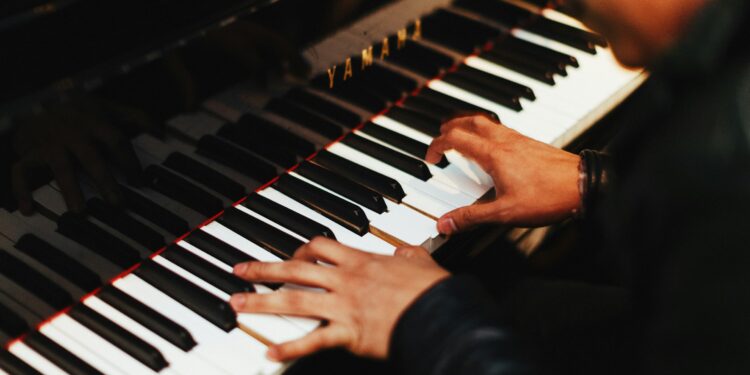Credit: UNSPLASH / CC0 public domain
Playing piano involves much more than hitting the keyboard. The whole body of the pianist is in motion, from the torso to the fingers. But how does the musical expression generated by this choreography increase the risk of self-inflicted long-term injury?
Seeking to answer this question, PH.D. The candidate Craig Turner and his research director, Felipe Verdugo, the Kinesiology School and the Sciences of Physical Activity of UdeM, decided to deconstruct the biomechanics of the performance of two professional pianists.
Their research is all the more relevant since 72% of pianists suffer from musculoskeletal disorders, according to the statistics cited in their article published in Borders in psychology.
Embodied cognition
To determine how embodied cognition – that is to say when there is a mutual influence between the thoughts of his thoughts and his bodily reactions – manifested himself in the two pianists, the researchers adapted each of them with 17 motion sensors.
The musicians then played six extracts from classic and romantic works under two very different sets of performance conditions: an expressive reading, comparable to a live concert, and a more “neutral”, in which the musicians were invited to play strictly what was written in the score, without authorized personal interpretation.
The sensors (called inertial units) were used to analyze three specific criteria: the amplitude of the joint movements of pianists, the postures they adopted and the sweetness of their wrist movements.
The objective was to study joint movements in the context of two styles of performance that pianists really use in their work.
“In doing so, we went beyond previous studies, which have generally settled to measure linear body movements, rather than the angles of each joint movement,” said Verdugo, specialized in the analysis of movements and biomechanics.
Amplified movement but contradictory risks
As expected, the results indicate that when the pianists play expressively, their body is also in a greater movement, not only the central joints (shoulders, neck, torso), but also external joints (elbows, wrists). This amplification affects almost all the joint movements measured by researchers, illustrating how musical expression is physically manifested throughout the body.
However, this excess expression has contradictory effects in terms of potential risks for the physical health of musicians. On the one hand, the nucleus is engaged in more dynamic and neutral postures, which could reduce the risk of musculoskeletal disorders in this region. On the other hand, the wrists – in particular vulnerable in pianists – devote more time in non -neutral and static positions, potentially increasing the risk of injury.
“We also found that the wrist movements become more jerks and less smooth when pianists play expressively, especially in more lyrical passages,” note researchers in their study. “This can constitute an additional risk factor because theacturation implies faster changes in the forces exerted on the joints.”
In the opinion of researchers, these risks are not insignificant given an excessive or inappropriate use of the wrist can lead to pathologies such as tendinitis or carpal channel syndrome. “These disorders, which are so common among musicians, could undermine the career of a pianist if these factors are not taken into account in practice routines and prevention measures,” they warn.
The musical context is decisive
The study also reveals that the type of music considerably influences the impact of the expression on joint movements. In very fast virtuoso passages, the differences in softness of the joint movements associated with the two performance styles tend to decrease.
“It is as if the technical constraints of these passages leave less room for movement variations associated with a more expressive game,” said Turner.
The following example illustrates this paradox: when the pianists played a virtuoso passage with fast -detached left notes, no difference was observed in the softness of the wrist movements between the two styles of performance.
This observation can provide a potential overview of interactions between technical and expressive performance requirements, according to researchers.
Better injury prevention
By sharing their data, Turner and Verdugo hope to underline the importance of adopting a holistic approach to pianist practice, reflecting the contradictory requirements of musical expression and physical health.
Their research could also have major implications for teaching piano and injury prevention.
“Traditionally, some piano teaching schools have discussed musical expression and technique separately,” they explain in their article. “Our study suggests, however, that the two aspects are intrinsically linked, biomechanically speaking.
“Thus, piano teachers could modify their approach by avoiding dissociating these aspects while monitoring how the students manage their body mechanics, depending on the type of music played.”
The data also shows that efforts to adopt a more ergonomic approach to pianist training in order to minimize body tension should be adapted to the needs of musical expression students. Exercises to ensure correct posture and smooth wrist movements could be used to reduce musculoskeletal risks.
“Pianists who seek to reconcile high -level performance and good health must be informed of the importance of properly managing the movements,” conclude researchers. “The integration of mobility exercises, suitable stretches and body awareness in practice routines could make a real difference. The call on experts specializing in biomechanics or musical ergonomics could also help prevent acute and chronic injuries.”
More information:
Craig Turner et al, Impact of expressive intentions on the heights of the upper body in two expert pianists, Borders in psychology (2025). DOI: 10.3389 / FPSYG.2024.1504456
Supplied by the University of Montreal
Quote: The study reveals how musical expression affects the risk of pianist musculoskeletal injury (2025, April 28) recovered on April 28, 2025
This document is subject to copyright. In addition to any fair program for private or research purposes, no part can be reproduced without written authorization. The content is provided only for information purposes.



